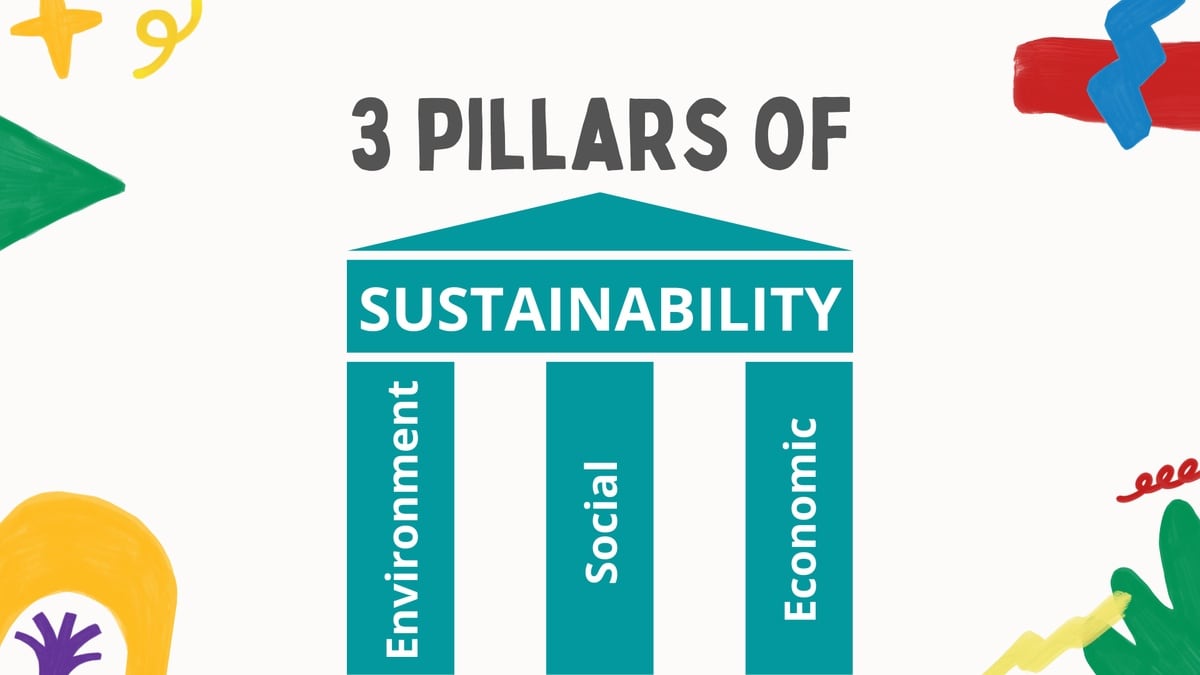Sustainability is often assumed to just mean environmental protection. But it’s actually a more complex concept that has three core pillars.
Key Takeaways
- Sustainability has three pillars: environmental, social, and economic.
- Environmental sustainability involves managing resources and reducing pollution.
- Social sustainability focuses on equity, justice, and community well-being.
- Economic sustainability requires businesses to balance profit with environmental and social considerations.
- The pillars guide sustainable development and influence global sustainability goals.
What Are The 3 Pillars Of Sustainability? The 3 pillars are environmental, social, and economic. These 3 principles provide a framework to evaluate sustainability for organizations, products, services, and technologies.
Understanding this “triple bottom line” model provides powerful insights into how to build a sustainable future. Let’s dive in!
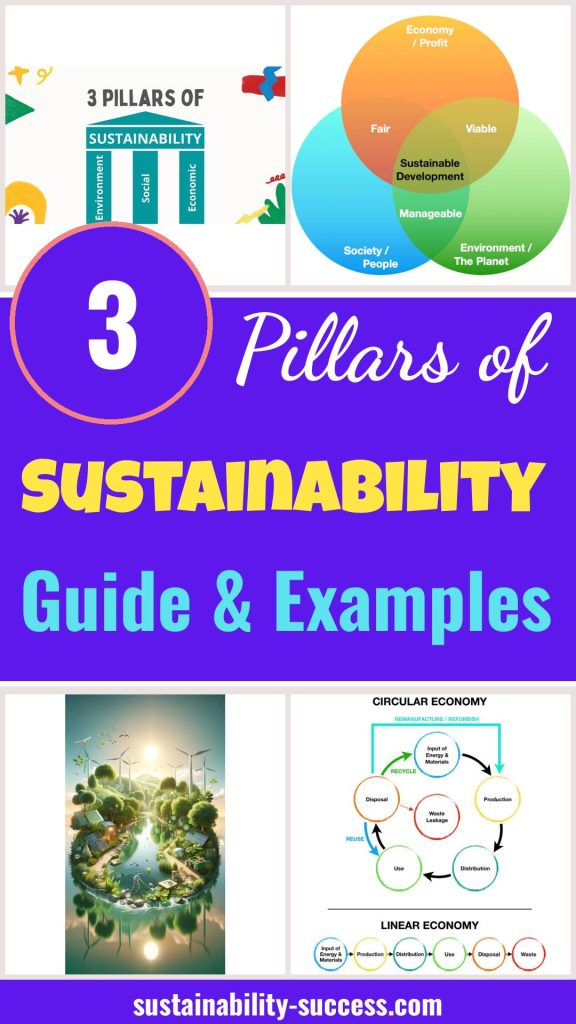
The three pillars of sustainable development were first mentioned in the Brundtland report in 1987. The 3 pillars mean that sustainable development can be achieved only when environmental protection, social equity, and economic profitability coexist without one area taking over any of the others.
According to this definition, the 3 pillars are seen as interacting with each other at the same level. While sustainable development resides at the intersection of the 3.
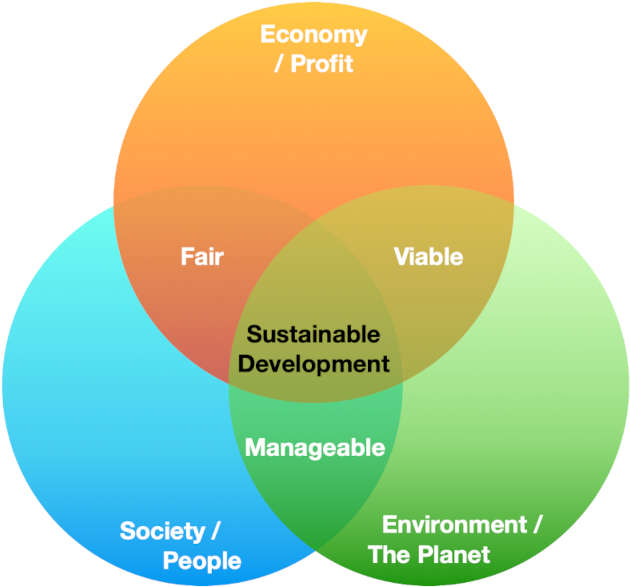
More recently, the three pillars of sustainable development were also outlined by the United Nations Millennium Declaration, and as of today, they represent the most popular model to evaluate and understand sustainable development.
More sophisticated interpretations are also recognizing that the three spheres of sustainability are not all at the same level but there is a hierarchy, where the economy is contained in the society and the society is itself contained inside the environment.
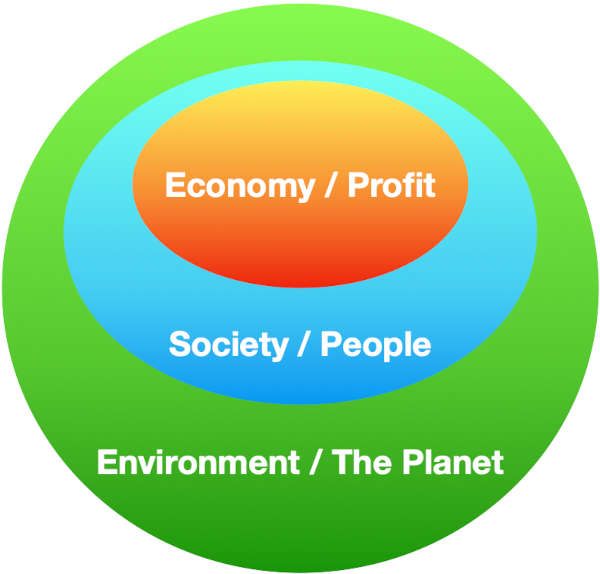
The three sustainable development pillars are often also referred to as people, profit, and the planet. They are also known as the 3 types of sustainability, 3 Ps of sustainability, triple bottom line, or 3 principles of sustainability.
The Environmental pillar of sustainability
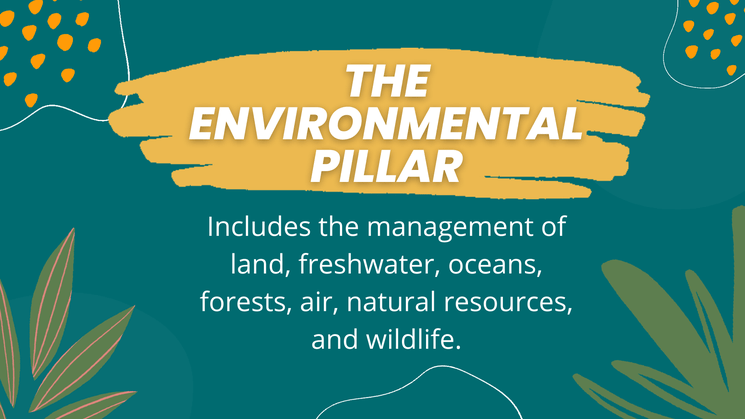
The environmental pillar of sustainable development involves regulations, laws, and other tools used to deal with environmental issues such as the management of land, freshwater, oceans, forests, air, natural resources, and wildlife.
Environmental management involves the use of environmental science and conservation biology to manage at a high level the allocation of resources such as land, water, and emissions to achieve a sustainable future.
This pillar of sustainability captures green factors and involves direct management of the environment with things like planting and preserving trees and taking action on the human consumption side. This involves things such as:
Reducing Energy Consumption and CO2 Emissions

Embracing renewable energy sources, adopting industry 4.0, switching to hybrid and electric vehicles, and enhancing energy efficiency can significantly lower carbon emissions.
Education also plays an important role and is important to incorporate environmental activities for students early on in their curricula. This will help to grow a new generation of environmentally conscious people.
Waste Management
To promote environmental sustainability, it’s crucial to shift away from the linear waste management model where materials end up in landfills. Instead, we should embrace a circular approach, prioritizing recycling, reduce waste, and minimize environmental harm.
Luckily, it is possible to recycle most things, including valuable materials like:
- Cardboard
- Copper
- Aluminum
- Scrap metal
Dietary Choices
One way to contribute to sustainability is by encouraging healthier and more sustainable dietary choices, such as adopting Mediterranean or Japanese diets that rely less on animal products.
The vegan diet can also help reduce the environmental impact, however, veganism has some drawbacks for the environment that should be taken into consideration.
Freshwater
Efficiency in freshwater usage can be improved by upgrading infrastructure and implementing green technologies, particularly in agriculture.
Simultaneously, managing the demand side through public education is crucial, as freshwater is a precious and limited resource.
Population
Statistics reveal that most of the world’s population growth occurs in the poorest areas of the planet, while the population of the richest nations remains relatively stable.
Promoting equality and improving living conditions for the less privileged not only aligns with ethical principles but can also contribute to curbing global population growth.
Cities
Sustainable urban planning and infrastructure development are crucial in achieving more sustainable lifestyles within cities. Thoughtful city planning can reduce environmental impacts and promote sustainable living practices.
Additionally, the integration of smart buildings and technologies in urban development can further enhance energy efficiency, reduce resource consumption, and improve the overall sustainability of cities.
Smart buildings utilize advanced systems and automation to optimize energy use, monitor environmental conditions, and enhance the quality of life for residents while minimizing environmental impacts.
The Social Pillar of sustainability
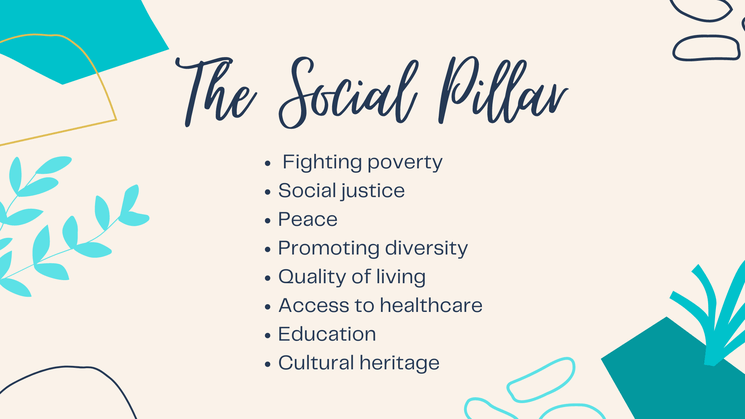
The social pillar refers to initiatives, public policies, planning, and regulations supporting social issues.
These include things such as fighting poverty, social justice, peace, promoting diversity, quality of living, access to healthcare, education, community development, cultural sustainability and heritage, and some aspects of religion.
Unfortunately, this is the least defined and understood pillar of sustainability compared to ecological and economic ones.
However, the social factor influences all human activities and as such, is strongly linked to the economic and ecological dimensions of sustainability and sustainable development.
More in detail, the main aspects of this type of sustainability are:
Security and human rights
Peace, security, and human rights are very important components of social sustainability, this is because wars, crime, and unethical practices are not only wasting valuable resources in destructive activities but are also ultimately bad for the environment.
Just think about all the pollutants dispersed into the environment during wars or from factories using unethical practices.
Access to healthcare
Access to healthcare is a central point of the social principle of sustainability. Many health-related issues are interconnected with the environment and economic aspects in general.
For example, in agriculture, green improvements like hydroponics and aquaponics are also helping to improve health-related conditions.
Finally, the World Health Organization is going as far as considering sustainability impossible to achieve without taking care of health-related issues.
Social justice
Poverty and lack of social justice are not allowing societies to make long-term plans, ultimately reducing human sustainability and well-being while also hurting the environment.
Influence of religion and culture
Cultural sustainability deals with beliefs, religion, and heritage conservation. Cultural aspects are without a doubt one of the drivers that can help to enable sustainable development.
In this respect, recent years saw some important contributions on the religious side that helped to attract more attention to the topic: with both the Dalai Lama and Pope Francis calling for more responsibility in fighting ecological degradation and preserving the ecosystems.
Those are just some social sustainability examples and how they can impact human society and quality of life.
The Economic Pillar of Sustainability
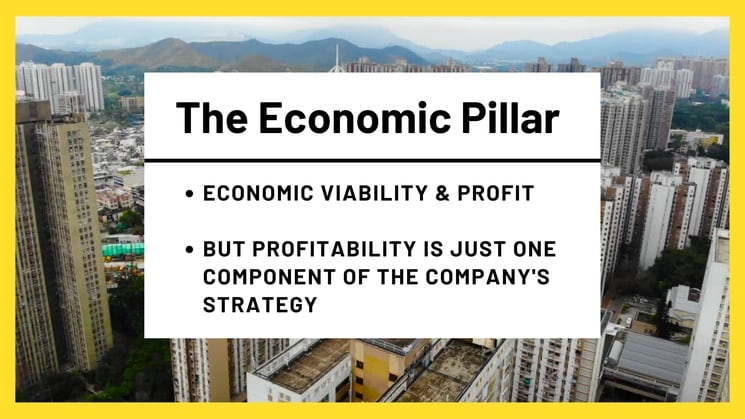
The economic pillar of sustainability is essential for the business’s existence: a business needs to be economically viable to be sustainable. At the same time, a sustainable business should look at profitability as just one component of the company’s strategy.
A conscious business leader aiming at sustainability should encourage a more balanced culture, where social and environmental factors are taken into consideration together with profitability and economic sustainability.
Another term for the sustainability pillar of economics is “Profit”. After all, the economy is based on offering a product or service making a profit.
Limited natural resources need to be accounted for
Unfortunately, often the limited resources available in the environment are not factored in: this is the main problem faced when trying to achieve long-term economic sustainability. There can’t be long-term economic growth if we deplete all the available natural resources.
The capitalist system based on the free market is an incredible tool to improper the standards of living of Western nations, however, this doesn’t take into account the limits of our planet: or better, it doesn’t until it is too late.
For example, in the current economic paradigm, a factory that is using non-renewable resources or a devastating open pit mining operation is not penalized because of the consequent environmental degradation.
The damage made is somehow passed on to the collectivity, as a result, the price of their final product will not be influenced by their unsustainable practices. The business doesn’t have a direct economic incentive to adopt more sustainable practices.
regulations to stimulate environmental Responsibility
One way around the just-described problem is to use government regulations to incorporate the damage made to the environment into the price.
This can be done through taxation and incentives: the government can impose a tax on unsustainable practices, such as emissions or excessive waste dispersed into the environment, while it can give a subsidy to more virtuous businesses.
Another concept that is being studied is the opportunity for decoupling economic growth from the degradation of the environment. This means that an increase in GDP would not necessarily mean increased pressure on biodiversity and ecological systems.
Influence of public opinion on business decisions
In recent years, thanks also to the increased environmental awareness of the public, sustainable business practices started to gain more traction. This generates new opportunities for businesses and corporations that are interested in embracing a sustainable business model.
Nowadays many businesses are trying to improve the perception of their brand by incorporating sustainability into their business plan. This is leading to new and more environmentally aware leadership, that, by improving the efficiency of different processes, is often able to improve sustainability without necessarily increasing the cost of the final product.
What is the circular economy?
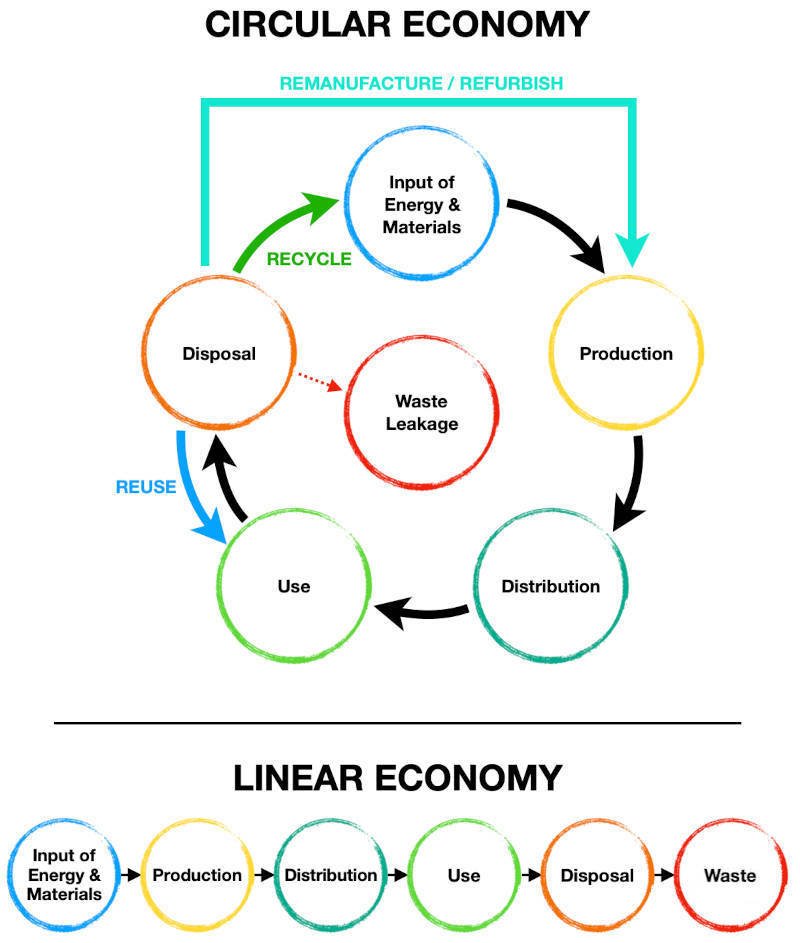
The circular economy is a new model of production and consumption that aims at improving sustainability by promoting: sharing, repairing, refurbishing, reusing, and finally recycling as much as possible of each product.
The circular economy aims at maximizing the use of manufactured products by sharing and leasing instead of owning them: essentially turning products into services.
Another important aspect of the circular economy is the design process. Products should be designed to be long-lasting, easy to fix, and recycled when their lifecycle comes to an end. For this reason, having a circular economy also implies having a circular supply chain.
What’s the difference between the circular and the linear economy? The circular economy concept is opposite to the one of the linear economy. In a linear economy, all the resources are pulled from the environment to produce goods that have a relatively low average use and are ultimately destined for landfills.
The objective of a circular economy is to create a closed-loop, where most of the resources are reused through recycling and the manufactured product is used as much as possible by extending its life using remanufacturing and refurbishment.
Also in the circular economy, there will be residual waste, but this will be minimal compared to a linear economy.
Criticism of the circular economy concept
Recent years saw the rise of several critiques of the circular economy model, let’s have a quick overview of the more interesting ones:
- Some criticize that the circular economy is still privileging continuous economic growth and just trying to improve the sustainability of the current linear model without really addressing the main issue.
- Corvellec, and Hervé (2019) focus on the unavoidability of waste, which should somehow be considered an inevitable byproduct of life. While in the circular economy, waste is considered a sign of failure.
- Geyer and Zink (2017) question the central assumption of the circular economy. Arguing that reusing and recycling may not be preventing the production of new goods due to economic reasons that are not considered in the circular economic model.
- Perhaps the most interesting critique comes from Korhonen, Jouni; Honkasalo, Antero; Seppälä, Jyri (2018) who argue that the circular economy model is violating the second law of thermodynamics. According to this fundamental law of physics, all spontaneous processes tend to equilibrium and lead to an increase in entropy. In other words: when trying to implement the circular economy in the real world, it will not be viable to recycle or reuse all the materials. Recycling all the materials would ultimately require systems that will use more energy than what those recovered resources will be worth. As a consequence, we will still have parts of the economy following the linear model.
Why are the 3 pillars important?
The 3 pillars are useful to better understand sustainability and how to have a more eco-friendly lifestyle, in fact, they are used as a reference to create other models such as the 6 Rs of sustainability.
The three principles of sustainable development are important because they offer a framework that can be used to evaluate the sustainability of an organization, business, product, or service.
Sustainable development goals and the 3 pillars
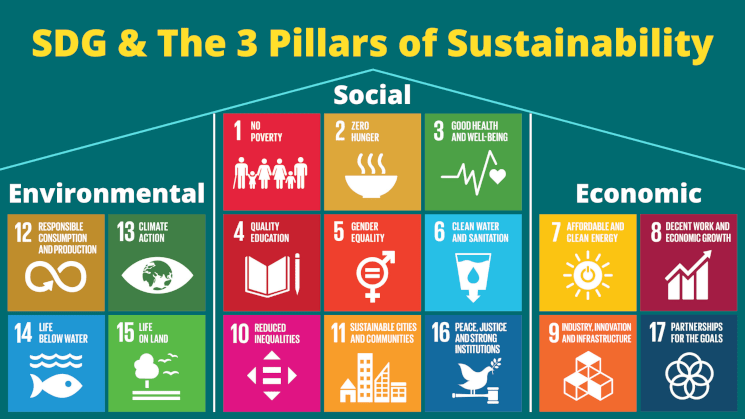
The three pillars of sustainability are important and relevant because the UN Sustainable Development Goals (SDG) are based on them. In fact, the SDG goals can also be categorized according to the three pillars.
Here are the sustainable development goals aggregated according to the three pillars of sustainability:
- ENVIRONMENTAL:
- SDG 12: Responsible consumption and production
- SDG 13: Climate action
- SDG 14: Life below water
- SDG 15: Life on land
- SOCIAL:
- SGD 1: No poverty
- SDG 2: Zero hunger
- SDG 3: Good health and well-being
- SDG 4: Quality education
- SDG 5: Gender equality
- SDG 6: Clean water and sanitation
- SDG 10: Reduced inequalities
- SDG 11: Sustainable cities and communities
- SDG 16: Peace, justice, and strong institutions
- ECONOMIC:
- SDG 7: Affordable and clean energy
- SDG 8: Decent work and economic growth
- SDG 9: Industry innovation and infrastructure
- SDG 17: Partnerships for the goals
certifications based on the 3 Principles of sustainability
The 3 pillars have been used as a guide to define several common standards and certifications. These include Fairtrade, the Rainforest Alliance, GLOBALG.A.P., and UTZ Certified, spanning sectors such as agriculture, fisheries, forest management, and mining operations.
In recent years the public has become more and more conscious about the importance of environmental issues, with damages to the reputation of companies that are keeping a short-sighted approach focusing purely on profit without consideration for the environment.
This led to an ever-increasing number of businesses and corporations committing to reach ambitious sustainability goals in the coming years. Those goals span from zero-emissions commitments to fight climate change to the pursuit of ethical manufacturing, inclusivity, and more.
the three pillars of sustainability and ESG
ESG stands for Environmental, Social, and Governance and it’s a relatively new standard used by a growing number of institutional investors to evaluate companies and countries in their sustainability efforts.
Only when enough data has been collected on those 3 areas they may be included in the list of stocks and bonds to be considered for investment.
The principles of sustainability are essential for ESG because they are the foundation of the framework used to derive ESG metrics for investments.
While traditional models consider only the economic performance of a company, the ESG evaluation involves all three pillars of sustainability: environmental, social, and economic.
This means that a company is not only evaluated by its balance sheet, but it will instead undergo a broader assessment regarding its long-term sustainability according to the 3 pillars.
This includes things such as gender diversity, employment equality, how the company is dealing with its carbon emissions, the use of renewable energy, product safety concerns, leadership sustainability commitments, and much more.
Conclusions
The three dimensions of sustainability are important because they help to better understand sustainability and they are also used as a model for standards and certifications to evaluate the sustainability of organizations, countries, products, and services.
More in general, the triple bottom line model can be used every time that we want to evaluate the long-term sustainability of literally anything!
Finally, there is also a different and more recent variation of the three pillars model, which emphasizes the human sustainability factor by adding one additional pillar. This model is called the four pillars of sustainability and I wrote a separate article about it.
I hope you enjoyed learning more about sustainable development and its three pillars, I’m sure that this knowledge will be very useful in your life and will help you to be more eco-friendly.

